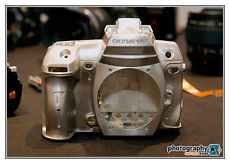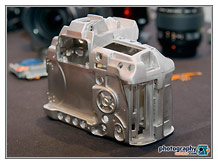Earlier in October we attended the Olympus E-3 digital SLR introduction party in New York City. A few days later I had a more detailed tech briefing on the new E-3 at the PhotoPlus Expo tradeshow. I met with Sally Smith Clemens and Toshiyuki Terada, Manager of DSLR Planning from Olympus Tokyo. At the meeting I got to see some of the guts of the E-3, including the image-stabilized Live MOS sensor assembly, the new auto focus drive system, and the specially formed magnesium camera chassis.
Read Part I of my Olympus E-3 Preview >>
Improved Image Stabilization
The E-3 shares the same basic sensor-shift image stabilization system that the E-510 uses. However, Olympus has increased the sensitivity of the gyro motion sensor that detects camera movement. The E-510 was supposed to be able to compensate for up to three stops of movement. Olympus is claiming that the new E-3 DSLR can successfully shoot up to four or even five shutter speeds slower. We shot a little video of the mechanism to show you how it works. Notice how the imaging sensor moves when Sally’s finger touches the image stabilization gyro.
E-3 image stabilization performance is impressive. Playing with the E-3 at the introduction, I was able to capture sharp handheld photos as slow as 1/6th of a second. And in better conditions I am pretty sure I could shoot even slower. I find myself liking and recommending in-camera image stabilization more and more. Olympus points out that a sensor-level system keeps the lenses smaller and lighter by eliminating image stabilization sensors or motors. The camera’s imaging sensor is much lighter and easier to move than a glass lens element and there’s no reason a camera system can’t be programmed to know which lens is mounted and adjust the compensation accordingly. You have to wonder if in-camera image stabilization isn’t starting bypass optical image stabilization. Olympus is claiming 5 stops of compensation for the E-3. Canon and Nikon are only claiming three stops on their best image-stabilized lenses. Think about it.
World’s Fastest Auto Focus System
As mentioned in our earlier Olympus E-3 Preview article, Olympus is claiming the new auto focus system in the E-3 is the fastest currently available, when used in conjunction with their new Zuiko Digital 12-60mm SWD (Supersonic Wave Drive) lens. This is a huge claim as auto focus is one of the key features many professional photographers consider when they choose a camera. Toshiyuki Terada, the Olympus Tokyo Manager of DSLR Planning, had both a Canon Ultrasonic (USM) auto focus assembly and the new Olympus SWD (Supersonic Wave Drive) actuator to show me how they both worked. Olympus contends that Canon’s USM drive is very fast once in motion, but slow on initial acceleration and braking. The Olympus drive system uses what Mr. Terada described as a galloping motion. They claim that the galloping motion drive system is faster to start moving and stop moving than other focus drive systems. The Olympus SWD lens drive combined with the E-3’s 11 crossed auto focus sensors certainly looks impressive on paper. Of course, we’ll need to do some field testing to evaluate the speed and accuracy of the new Olympus auto focus system. But the new auto focus system is the most interesting feature of the Olympus E-3 and we’re really looking forward to seeing how it performs.
My first impression of the E-3’s auto focus, at the Olympus E-3 introduction, was very positive. I brought my own Canon Digital Rebel XTi (EOS 400D) to shoot the event. Poor, spotty indoor lighting and dusk conditions outdoors had the XTi AF hunting and stalling on many shots. And I’m not criticizing my camera. My experience with the XTi has been very good and the lighting was pretty crappy. However, in spite of the poor light, the E-3 auto focus was surprisingly quick to react and seemed to focus quickly and accurately no matter how dark the subject. This isn’t at all a definitive test so take it with a grain of salt. But I couldn’t help but notice the difference and it’s made me even more excited about testing the E-3.
Olympus E-3 Construction
The Olympus E-3 is not just a plastic case with a digital sensor and a bunch of printed circuit board inside. It was built to take some serious abuse. To protect it from the elements, there are gaskets on all openings that might let moisture in. And beneath the plastic exterior is a specially constructed three-piece “thixomold” magnesium chassis. The thixomold process forces molten magnesium into a mold under pressure. The pressure eliminates any bubbles or weak areas and produces an extremely strong, detailed internal camera frame. So strong, in fact, that Olympus handed one to me and asked me to stand on it. Looking at it, you’d expect it to crumple like an empty aluminum can. But the thixomold magnesium frame is very rigid and supported my weight with no problem (see below). When I stood on it I couldn’t feel any flex or give. After that little demonstration I have no doubts about Olympus’ intentions to make the E-3 as burly and durable as possible. And really, should we expect any less from the company that gave us the Stylus 720 SW, the first shockproof point-and-shoot digital camera?
Conclusion
Without a camera in hand to test we can’t come to any definitive conclusion. But it’s obvious that Olympus isn’t messing around with the E-3. Past Olympus FourThirds DSLRs have attracted me mostly because of the compact size of the lens/body combo. Since I ride my mountain bike with a camera, size and weight are critical issues for me. And I really liked shooting with the E-510 while we had it for testing. But the E-3’s features and build put it in another class from previous Olympus E-System digital SLRs. That even goes for the E-1, which was a great camera in many ways. But it still didn’t quite measure up to the competition. The E-3, on the other hand, meets the competition head on. Any photographer considering a Canon EOS 40D, Nikon D300, Pentax K10D, or Sony A700 should also be taking a hard look at the Olympus E-3. Unless there turn out to be problems with the camera’s performance or image quality, I think the E-3 is a solid competitor. I look forward to getting one and giving it a real test.
Olympus E-3 Preview Part I >>
Olympus E-3 DSLR press release >>
Olympus Digital SLR reviews >>
All Olympus reviews >>
Olympus & Four Thirds forum >>
Digital SLR forum >>
Olympus Web site >>







well come E3 we wait long time then you are in our pro hands with your great lenses .thanks Olympus.Saad Ismail . WN , MB Canada.
better shutter (faster and rated for more use), Low noise at high ISO, Professional Body, and it kept the water resistance and dust removal filter that work very well for the E-1. Live view is useful and easy to use many Manual lens.
Nice to hear comments of Professional photographers like Saad Ismail